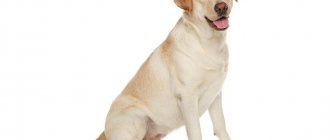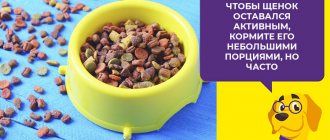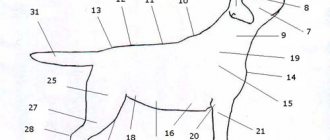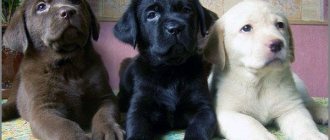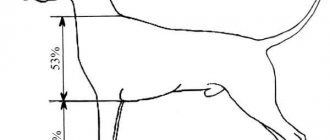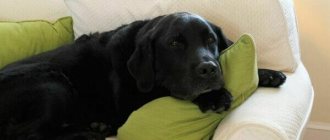What colors do Labradors have?
If we classify Labradors depending on their color, these dogs are black, chocolate and fawn.
Each color also has subspecies. The Labrador has remained one of the most popular dog breeds for many years. These are wonderful companions and reliable friends of man. The Labrador is a large, powerfully built dog whose weight reaches 35 kilograms and height at the withers is 60 centimeters. Dogs of the Labrador Retriever breed differ from each other in color. Thus, there are black, brown (chocolate) and fawn Labradors.
Advantages of the Labrador Retriever breed
Labradors deserve their popularity not only for their friendly disposition. They are excellent swimmers, hunting assistants, and have a sense of smell that has virtually no analogues among domestic dogs.
For example, a German shepherd copes with search activities 25% worse.
Photo 5. Labrador retriever in service
Labradors are very smart, they are used in the police service (usually for searching and finding missing things, weapons, drugs, banknotes), and they cope well with the role of guides for the blind.
And this is not the entire list of amazing, useful and important qualities of the Labrador.
According to research conducted in the United States, these dogs are among the four most popular breeds worldwide.
How was such a universal breed formed? Was she always so loved and was she always such a good friend to man?
To answer these questions, let's take a brief excursion into the history of the Labrador breed.
A short history of the origin of the breed
The history of the Labrador Retriever breed has a large number of mysteries that have not been solved to this day. It is known that representatives of this breed came to the European continent from the island of Newfoundend, which belongs to Canada, but this version of the spread of the breed in Europe remains unconfirmed.
The first dogs of the Labrador breed were only black in color, which is how they got their name. For reference: Labradorite is a resin-colored semi-precious stone mined on the North American continent. In the nineteenth century, only black color was officially recognized. By the end of the nineteenth century, breeders managed to obtain fawn and brown puppies.
History of the Labrador Retriever breed
The history of the emergence of Labrador is covered, if not with darkness, but with a slight haze, through which various versions of the formation of modern Labrador seep through to us every now and then. Four main theories of the origin of the Labrador breed deserve attention.
The first theory, which has the largest number of supporters, states that the ancestors of Labradors were Newfoundlands, which were crossed with another little-known large dog. It could have been a small Newfoundland dog, or a Saint John dog.
At that time (roughly the 19th century) on the island of Newfoundland, breeders focused on two breeds of dogs.
From the first of them came the modern thick-haired breed, which eventually received the name “Newfoundland”, and the second was slightly smaller in size. She became the founder of the Labrador Retriever breed.
Since scientists still cannot trace the ancestors of the St. John's dogs themselves, it is generally accepted that the roots of the breed are on the island of Newfoundland (an island off North America on the northeastern side, separating the Gulf of St. Lawrence from the Atlantic Ocean; it is part of the Canadian province of Newfoundland and Labrador).
Photo 6. St. John's Dog
The second theory is based on the fact that initially the so-called water dogs were brought to the island of Newfoundland, which eventually became the ancestors of Labradors.
Using Portuguese water dogs, people practiced the same working qualities that later became characteristic of Labradors - pulling nets and boats out of the sea, rescuing drowning people (in particular, necessary things, “escaped” fish, etc.).
In this regard, the conclusions about the origin of Labradors from Portuguese water dogs are quite justified.
The third theory (it has been proven to be untenable more than once) states that the ancestors of Labradors were the dogs of the Indians of North America.
The theory turned out to be untenable after archaeological excavations, which indicated that Indian dogs were of a completely different type and could not possibly have become the ancestors of Labradors.
The fourth theory claims that the roots of Labradors should be sought among the dogs of the ancient Scandinavians who settled on the island before our era.
The above dogs mixed with the dogs of the ancient Basques who inhabited the Labrador Peninsula in the 16th-18th centuries. However, there is no genuine documentary evidence of this.
Genetics
Labrador color plays a key role in breeding pedigree dogs. There are established combinations of genes responsible for the color of Labradors, and a detailed study of the Labrador's pedigree allows one to avoid problems with the purity of the breed.
In genetics, the letters B and E indicate black coat color. These genes are both dominant. Chocolate and fawn colors are indicated by the letters b and e, and these are recessive genes. There are 9 different gene combinations in total. A puppy receives a pair of genes from each parent.
A black Labrador with the EEBB gene combination has only black dogs in its family. However, if you breed such a Labrador with a carrier of one of the recessive genes (fawn or chocolate), then there is a possibility that the puppies, upon reaching the age of an adult dog, will give birth to fawn or brown Labradors.
The birth of black puppies from fawn parents becomes a cause for surprise among inexperienced breeders. However, from a point of view, this situation is not at all surprising: a fawn Labrador, regardless of gender, can act as a carrier of the black color gene.
When visually assessing a dog, it is impossible to determine the combination of its genes responsible for the color of the animal. You can find out information about gene carriage only after the Labrador has produced offspring. You can also find out information about the Labrador’s closest generations of relatives from its pedigree, but this information is not enough to evaluate the entire pedigree of the pet.
Description of the breed
FCI standard No. 122 dated October 13, 2010 Labrador Retriever Group 8 “Retrievers, spaniels and water dogs.” Section 1 “Retrievers”.
Height: 56-61 cm (males), 52-56 cm (females).
Weight: 27-40 kg (males), 27-35 kg (females).
What does a Labrador Retriever look like? This is a strong and muscular dog, very active (which excludes the presence of excess body weight or substance).
| HEAD | The skull is wide, clean lines, without fleshy cheeks. Stop is expressed. The nose is wide, with well-developed nostrils. |
| EYES | Medium size, expressing intelligence and good character, brown or nutty. |
| EARS | Not wide or heavy, hanging, close to the head, set far back. |
| TEETH | Jaws of medium length; The jaws and teeth are strong, with a perfect, regular and completely scissor bite, i.e. the upper incisors completely overlap the lower ones, the teeth are set vertically in the jaws. |
| NECK | Clean lines, strong, powerful, well placed on the shoulders. |
| BREAST | Good depth and length, with well-curved, barrel-shaped ribs - but this effect should not be achieved at the expense of excess weight. |
| PAWS | Round, balled, arched with well-developed pads. |
| TAIL | Distinctive feature of the breed; very thick at the base, gradually tapering towards the end, of medium length, without dewlap, but covered on all sides with short, thick, dense hair, giving the roundness of the “otter” tail. Can be carried gaily, but should never curl over the back. |
| WOOL | Short, thick, without waves or fringes, hard to the touch; with a thick, weather-protective undercoat. |
| COLOR | Solid black, fawn or chocolate/liver. Fawn ranges from light cream to fox red. A small white patch on the chest is acceptable. |
How long do Labradors live? They delight the owner for an average of 12 to 14 years.
Differences from the Golden Retriever
People often ask: what is the difference between a Labrador Retriever and a Golden Retriever? Here are three clear differences:
- Color. A Labrador is allowed three colors, a Golden Retriever is allowed one.
- Wool structure. Labradors have a short and coarse coat, while the Golden Retriever has a flowing and soft coat.
- The nature of the Labrador is playful, cheerful and cheerful. Golden is thoughtful and dreamy.
Labrador Retriever
Golden retriever
Black color
Black Labrador, which fully complies with the standard, is characterized by a completely resin color. The limit of the acceptable norm is considered to be a barely noticeable whitish spot in the chest area of the animal. The nose of a purebred black Labrador is charcoal in color and lacks pigmentation. However, during the lack of sunlight that characterizes winter and autumn, the nose of a black Labrador may lighten to a pinkish tint. The pigmentation around the eyelids and lips is also pure black. The eyes of a black Labrador have a rich brown, less often a hazel tint.
Disqualifying faults for black Labradors include:
- motley spots of white, red and brown;
- nasal pigmentation.
Features of development
Briefly about the breed itself. The Labrador is a medium-sized dog with a balanced psyche, a true friend and companion for the whole family. He loves children very much. True, he’s not a good guard at all. He is always happy to have guests in your home. The breed was developed in the 19th century. There are several versions of why it was called that. The first is based on the name of the Labrador Peninsula. The second is in honor of a black rock called labradorite. Third, dogs are very hardy and hard workers, and from Portuguese “Labrador” is translated as “hard worker.”
There are three stages in development. All of them pass during the first year of a dog's life. The first lasts about four months and is characterized by rapid growth. During this stage, the puppy gains weight every day. The second, from five to eight months, implies slower development. At the third stage, which lasts from eight months to a year, a very slight increase occurs.
Brown color
The chocolate color of the Labrador comes in different variations. The “standard chocolate” dog has a coat that resembles milk chocolate. The nose of such a Labrador has a color similar to the color of the coat. The dog's eyes have a hazel or greenish tint. Labradorite shade of light chocolate is also called liver. This dog is characterized by a brown nose and a pink border around the lips. The dark chocolate-colored dog resembles a black Labrador with its dark color. Eye color varies from rich brown to light hazel.
The list of disqualifying faults includes the presence of white and black spots on the dog's coat. The standard allows for a small black spot on the dog's chest.
How to choose the right color puppy
Retriever and Labrador: what is the difference, differences between breeds
When choosing a puppy, it is important to pay attention to its appearance and color, especially if you plan to further participate in exhibitions. According to the standard, three types of colors are allowed: fawn, white and black. Fawn includes all colors that start from light sand and end with fiery red. In addition, the color of such dogs is uneven, for example, it may be darker on the back and lighter on the head, or vice versa. If you choose a fawn Labrador, you should take into account that with age it can change, darken or, on the contrary, lighten.
Choosing a puppy
As for the black Labrador, these are magnificent dogs whose fur shimmers in the sun and shines, but do not panic if the puppies have dull fur, it will change as the animal grows and this will pass.
There are also many varieties of brown dogs, ranging from chocolate to pure copper. These dogs may have a white spot on their chest. The only drawback of the chocolate color is that the coat fades in the sun and becomes a dull dark sand color.
Note! Before buying a puppy, you need to see it in person, since photographs do not convey 100% of the color of the coat.


